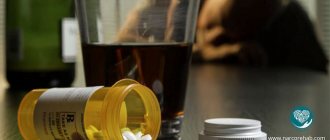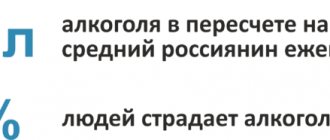Anonymously
Around the clock
Attention! The material contains information about substances, the use of which can cause serious harm to your health!
Article prepared by an expert
Egorova Yulia Viktorovna
Psychologist, diagnostician, author of rehabilitation programs for addicts. Member of the Association of Cognitive Behavioral Psychotherapy. More than 7 years of experience working with addicts and their families.
Reading time: 4 minutes
Read in the article:
- Purpose of the drug
- Use of Trigan-D by drug addicts
- Signs of intoxication
- How addiction develops
- Health implications
- First aid and addiction treatment
The drug Trigan-D is a pain reliever, but in case of overdose it has side effects that attract drug addicts. The easy availability of the drug for different segments of the population has caused a surge in consumption, which is why many experts are calling for the drug to be classified as a narcotic. What effect Trigan-D has on the human body, how addiction develops and how to treat it, read our article.
Use of Trigan-D by drug addicts
Due to the relaxing and calming properties of the drug, which are enhanced when taken in large doses, it has gained popularity among drug addicts. If you take Trigan-D for a long time, negative and painful sensations gradually begin to appear. At the same time, the person does not understand why he is tormented by such symptoms and does not notice the already formed dependence on the medicine.
Drug addicts get the desired effect by taking the drug in excess of the specified norm, which is manifested by different sensations in the addict’s body:
- slight euphoria and relaxation;
- lightness comparable to alcoholic intoxication.
The effect occurs 30 minutes after taking the drug and can last up to 3 hours. Combination with alcohol provokes unpredictable reactions. If the dose is greatly exceeded, a person feels internal tension, experiences hallucinations and memory problems.
Why use Trigan-D?
Trigan is a pain reliever for various problems with the gastrointestinal tract. It contains dicycloverine with paracetamol. Paracetamol is known to be an analgesic, but in large doses it has a detrimental effect on the body. Dicycloverine in large quantities stupefies the mind, and its abuse leads to mental disorders. For the purpose of anesthesia, adolescents take trigan in dosages exceeding therapeutic ones, for example, if you take 10 tablets at a time, distortion of reality, hallucinations, and blurred vision will follow. You may feel some relaxation and at the same time weakness and fatigue. As a rule, the addict soon falls asleep. Trigan abuse forms an addiction that develops in the usual way - a gradual increase in dosage. If you have this addiction, you need to go to a drug treatment center.
Among substance abusers, a common technique is to use trigan with alcohol, this allows you to enhance the effect of the pills. The pursuit of a short-term high can also lead to drunkenness and the need for alcoholism treatment.
How addiction develops
Trigan-D blocks pain centers and reduces pain after surgery. Taking a small dose, the addict experiences relaxation and euphoria. At the same time, the drug causes irreversible changes in the human body. By acting on pain receptors, it suppresses their functioning, and the negative consequences of use are felt only when the drug is discontinued.
First, a person gets used to psychologically relaxing by taking pills. And when a small dose ceases to bring the same pleasure, it increases the amount of substance consumed. At the same time, an overdose, as well as refusal to take the medicine, lead to negative symptoms. This is how a person falls into the trap of addiction.
Why is Trigan D used in medicine?
Trigan D is a medicine that has a long-term analgesic, antispasmodic and sedative effect. It is prescribed for irritable bowel syndrome, pyloric spasms, colic in the kidneys, liver and gall bladder, and dysmenorrhea. Thanks to the presence of paracetamol, an antipyretic effect is achieved; the drug relieves unpleasant symptoms of colds. The analgesic blocks COX in the central nervous system, blocks pain centers and reduces the manifestations of neuralgia, sciatica, myalgia, and pain after interventions.
Dicycloverine, which contains trigan, is a substance related to tertiary amines. He:
- suppresses the secretory activity of glands;
- dilates bronchioles;
- reduces spasms by relaxing the smooth muscles of blood vessels and the walls of the digestive tract.
In a combination of drugs, the effect is accelerated and intensified, causing a narcotic effect when taking Trigan D.
Health implications
With long-term use of Trigan-D side effects occur:
- constipation and vomiting;
- thirst and difficulty swallowing;
- disturbances in the functioning of the heart;
- drowsiness and weakness;
- allergies and dry skin.
Similar symptoms may occur when taken as prescribed by a doctor. If you use the medicine uncontrollably, the consequences can be much worse: chills, limb failure, muscle spasms or hallucinations.
It is especially dangerous to combine the drug with alcohol because it contains a high concentration of paracetamol. If you take a pill with beer or wine, it can lead to irreversible damage to the liver and kidneys.
Consequences of overdose and help with it
Trigan D tablets are a drug that is especially dangerous in overdoses and long-term abuse, but side effects also occur when taken in therapeutic doses. The instructions for use indicate the consequences of taking it:
- difficulty swallowing, dry mouth, thirst;
- constipation, decreased gastrointestinal tone, vomiting;
- tachycardia and heart rhythm disturbances;
- dizziness, drowsiness;
- allergic reactions, dry skin;
- urinary incontinence and so on.
If you take Trigan D uncontrolled, the consequences can be much worse. The drug causes chills, fever, visual and auditory hallucinations, convulsions, and paralysis of the limbs. Trigan D is a drug that, in severe cases, causes renal necrosis, which is fatal. If symptoms of poisoning are detected - “glassy eyes”, wandering pain in the gastrointestinal tract, nausea and vomiting, euphoria followed by drowsiness - you must urgently seek medical help. Doctors rinse the stomach, prescribe enterosorbents, intravenous drugs to increase conjugation reactions and the formation of glutathione. An overdose of Trigan D is treated in a hospital setting.
The drug is especially dangerous in combination with alcohol. Due to the ultra-high content of paracetamol (Trigan tablets contain it in the maximum permissible concentration), even a small bottle of beer provokes irreversible toxic damage to the liver and end-stage renal failure. With the development of psychological and physical dependence, the patient’s life is constantly under threat. That's what trigan D is.
First aid and addiction treatment
The life of a person who uses Trigan-D in large doses is under constant threat. Poisoning with the drug is especially dangerous, which is accompanied by the following symptoms:
- “glass eyes”;
- stomach ache;
- nausea and vomiting;
- alternating euphoria and drowsiness.
If such symptoms appear, it is necessary to call an ambulance and provide first aid to the person:
- induce vomiting or perform gastric lavage;
- sit the person down and monitor him to ensure he is conscious;
- Give activated carbon at the rate of 1 tablet per 1 kg of weight.
An overdose is treated in a hospital setting: the stomach is washed out, intravenous drugs are prescribed to restore normal functioning of the body. Detoxification is the first step towards recovery from addiction. Often, having experienced the negative consequences of drug use, a drug addict decides to seek rehabilitation. It is important to support him in this decision and begin treatment immediately.
The danger of Trigan-D is that it is available without a prescription and its consumption is not controlled. However, an overdose can lead to fatal consequences, especially for a teenager or a weakened body. It is important to detect the problem in time and seek help from specialists.
Do you suspect that your loved one is using drugs? Sign up for a free consultation by calling the hotline of the center for professional treatment and rehabilitation “Zdravnitsa”: 8-800-200-27-23 . Our specialists will conduct drug testing, create an individual treatment plan and provide support at each stage. We guarantee results if all our recommendations are followed.
Similar articles:
Drug Krokodil: desomorphine
May holidays 2021: Putin's decree banning alcohol
What to do if a child is a drug addict? Advice for parents of teenagers
Female alcoholism: symptoms and consequences
Drugs. How long after consumption the test will determine
Trigan D effect and the emergence of drug addiction
The main effect of the drug and its analogues is analgesic. When the therapeutic dose is exceeded, mild euphoria is observed; in severe cases, hallucinations are observed, which outwardly look like schizophrenic delusions. Drug addicts call the effect caused by Trigan D a “trip” - by analogy with synthetic hallucinogenic drugs.
Dicyclomine is maximally concentrated in plasma one to one and a half hours after taking the tablets, and paracetamol after 30 minutes. The peak effect is observed 2 hours after receiving the drug. Drug addicts who take Trigan “see” realistic pictures, not always positive and colorful. People addicted to the drug talk to non-existent interlocutors, they begin to become paranoid and panic.
Trigan is a drug that is common among teenagers and schoolchildren (there it is called “trigande”, “triganda” or “trigana”). It is easy to get, it is inexpensive, and is sold in almost all pharmacies. Dicycloverine (the drug has an effect primarily due to its presence) is isolated from tablets in home or “clandestine” conditions to enhance its effect. This is how addiction is formed, which inevitably destroys the organs and psyche. Trigan D is a potent anticholinergic that affects neurotransmitters in the brain, and the consequences of its use are unpredictable - including mental illness, liver failure and coma.
Content:
- Description of the drug
- Narcotic effect
- Consequences and first aid for overdose
- What to do if drug addiction is detected
Trigan-D is a drug with a combined effect, an antispasmodic and analgesic. This is a non-narcotic substance, but it is persistently addictive ; with long-term use, severe side effects occur.
What to do if addiction is detected
It is impossible to eliminate addiction on your own, since a persistent psychological addiction is formed. Narcologists compare addiction to Trigan with cocaine, heroin, and amphetamine addiction. After detoxification and elimination of withdrawal symptoms, complex therapy is prescribed.
Stages of treatment:
- Rehabilitation therapy. Drugs are prescribed to eliminate dysfunction of internal organs.
- Psychotherapy. The psychotherapist helps the patient make a conscious, voluntary decision to undergo the full course of treatment.
- Coding. They use classical or Ericksonian hypnosis, the method of Marshak, Dovzhenko.
- Rehabilitation. Various methods are used to eliminate psychological dependence. The doctor teaches the patient to cope with stress without doping. The addict attends group and individual classes. Effective methods are the 12-step program, art therapy, occupational therapy, communication with former drug addicts.
- Social adaptation. Resocialization is aimed at returning a healthy person to society and preventing breakdowns.
- Additionally, specialists work with relatives of drug addicts to eliminate codependency.
With long-term addiction, it will take at least 9 months to fully restore mental and physical health.
Trigan-D is a strong anticholinergic that disrupts the functions of neurotransmitters. The consequences of taking the drug in large doses can be unpredictable - severe mental disorders, liver failure, coma.
Description of the medication
The medicine is available in two forms. The tablets contain paracetamol and dicycloverine. The ampoules contain dicycloverine chloride and water. Available in pharmacies without a prescription. But experts in the field of addiction believe that the medication should be included in the group of prescription drugs.
The drug has a pronounced analgesic, sedative, antispasmodic effect. Therapeutic dosage: 1 tablet 40 minutes after meals, no more than three times a day. Take without a doctor's prescription for no longer than 3-5 days.
Indications for use:
- irritable bowel syndrome;
- pylorospasm;
- renal, hepatic colic;
- dysmenorrhea, other gynecological diseases;
- neuralgia, sciatica, myalgia, rheumatism, radiculitis;
- oncological pathologies;
- pain syndrome after operations;
- headache, toothache;
- colds.
Tablets and injections are contraindicated for persons under 15 years of age and for people under the influence of alcohol or drugs. The drug should not be taken for diseases of the blood, heart, kidneys, liver, prostatitis, intestinal blockage, peptic ulcer.
If the dosage is exceeded or the medication is taken for a long time without control, a person becomes a drug addict. Addiction develops within 2-3 weeks. Pharmacy drug addiction is common among teenagers. Dangerous stimulant medications are taken by schoolchildren over 12 years of age.



